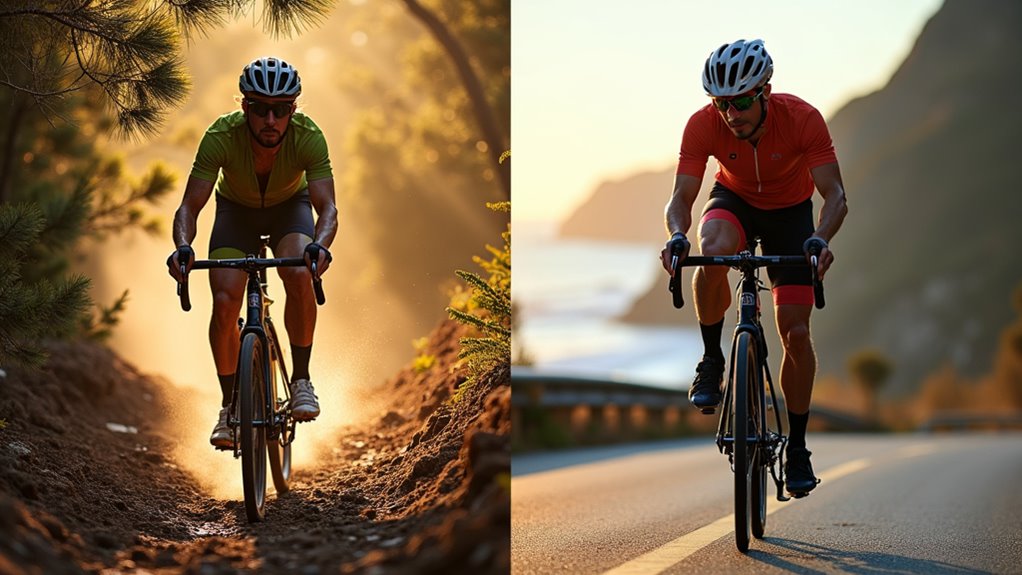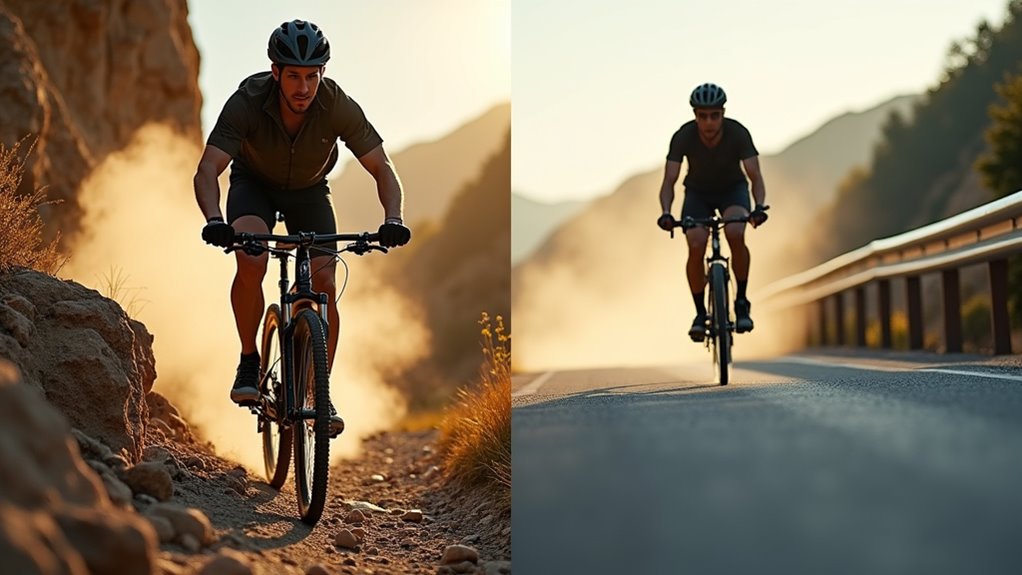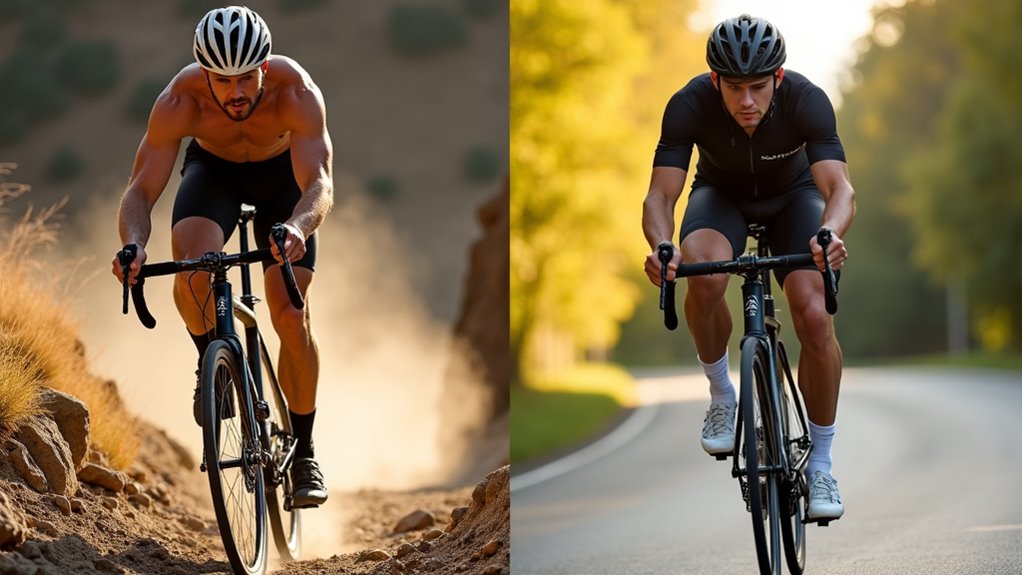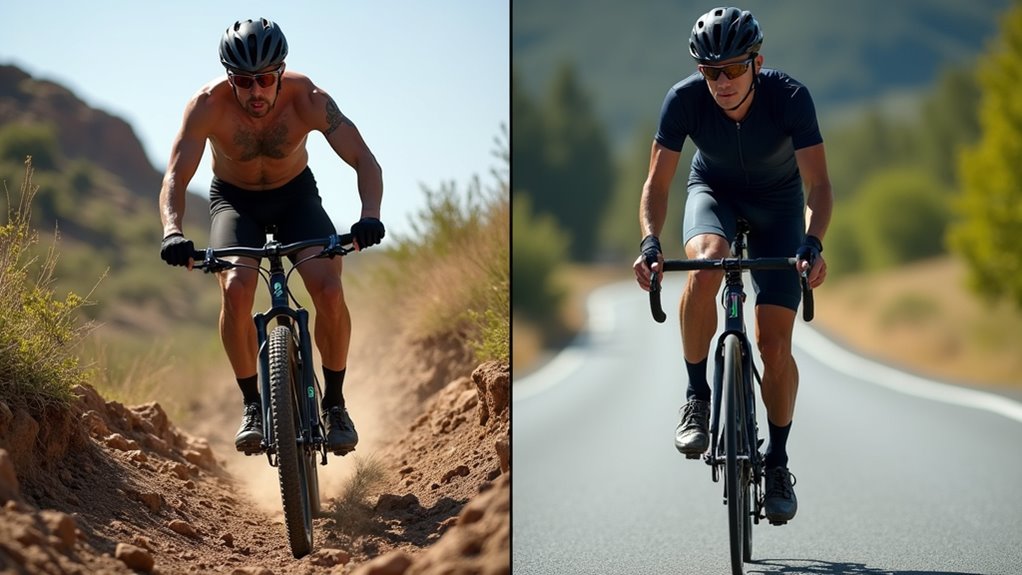Physical Address
304 North Cardinal St.
Dorchester Center, MA 02124
Physical Address
304 North Cardinal St.
Dorchester Center, MA 02124

Seeking the perfect cycling style? Discover the key differences between mountain and road biking before making your two-wheeled investment.
Picture yourself at a crossroads, where two paths diverge: one leads to rugged mountain trails, while the other stretches along smooth asphalt. If you’re considering which type of cycling to pursue, you should take into account several key factors that’ll impact both your wallet and riding experience. From initial gear investments to ongoing maintenance costs, each discipline offers distinct advantages and challenges. Before you commit to either path, let’s explore what makes each style uniquely appealing.

Statistics paint a revealing picture of safety differences between mountain and road biking. While recreational trail riding shows relatively low injury rates of 0.4-1.4 per 1,000 hours, competitive and downhill mountain biking present markedly higher risks, especially for women who experience up to 46.8 injuries per 1,000 hours in downhill riding.
You’ll face different hazards depending on your chosen discipline. Road cycling’s main risks come from vehicle collisions and traffic conditions, while mountain biking’s challenges include natural obstacles like rocks, roots, and varying trail conditions. The risk of road cycling incidents is particularly high on arterial roadways, which account for 65% of bicyclist deaths despite making up only 10% of roads nationwide.
Though mountain biking might seem more dangerous, it actually results in fewer fatalities than road cycling due to limited vehicle interaction. Your skill level plays a vital role – experienced riders typically navigate both disciplines more safely, making proper training a worthwhile investment in risk reduction.
Proper equipment stands between you and potential injuries on any bike ride, making gear selection a natural extension of safety considerations.
Your helmet choice is vital: road cyclists need lightweight, aerodynamic options, while mountain bikers should opt for enhanced protection with full-face or open-face designs. Both should prioritize helmets with high-density foam and advanced safety technology for maximum protection.
You’ll need discipline-specific clothing that matches your riding style. Both sports require moisture-wicking fabrics and padded shorts, but mountain biking demands more durable, tear-resistant materials.
Don’t skimp on tire essentials – road bikes need narrow, smooth tires for speed, while mountain bikes require wider, knobby ones for traction.
Carry appropriate repair tools: basic multi-tools work for road cycling, but you’ll want more extensive tools for mountain biking’s complex components like suspension systems and dropper posts.

Understanding the physical demands between mountain and road biking reveals stark differences in how you’ll need to train your body.
Mountain biking requires explosive power and full-body strength, with frequent bursts of high-intensity effort and technical maneuvering. You’ll need strong upper body, core, and grip strength for handling rough terrain. Cross-training benefits can significantly enhance overall performance and help prevent common riding injuries.
Road biking focuses on sustained cardiovascular endurance and lower-body strength, with steady power output over longer distances. You’ll maintain consistent cadence at moderate to high speeds, primarily engaging leg muscles.
While road cycling is more efficient per mile, mountain biking burns approximately 51% more calories due to terrain challenges and bike suspension demands.
Your training should reflect these differences: incorporate plyometrics and upper-body conditioning for mountain biking, while emphasizing lower-body endurance work for road cycling.
When selecting your ideal riding terrain, the choice between mountain and road biking hinges on several practical factors that affect both your experience and budget.
Consider your location’s accessibility – road cycling offers more convenience with readily available routes from your doorstep, while mountain biking often requires travel to specific trail systems. Mountain biking demands skilled navigation through changing trail conditions.
Urban dwellers will find road cycling more practical, with immediate access to paved surfaces and connected routes. If you’re near forests or parks, mountain biking becomes a viable option, though you’ll need to factor in transportation costs to reach trails.
Your terrain choice also impacts equipment investments – road bikes work best on predictable, smooth surfaces, while mountain bikes require robust components to handle rough trails.
Think about your daily schedule too, as road routes typically allow for longer, consistent rides compared to technical mountain bike sessions.

Both mountain and road biking offer distinct fitness advantages that’ll shape your overall health outcomes and training goals.
Mountain biking excels at total body conditioning through high-intensity intervals, engaging your upper body, core, and legs while traversing technical terrain. You’ll develop better coordination, balance, and reflexes as you tackle varied trails. Riding on steep climbs consistently helps develop explosive strength and power output.
Road biking delivers superior endurance benefits through steady-state cardio, primarily targeting your leg muscles and aerobic capacity during long-distance rides. You’ll build impressive stamina and consistent power output on paved surfaces.
For maximum fat loss, mountain biking’s combination of strength, cardio, and interval training gives you more bang for your buck.
However, if you’re focused on building pure endurance and aerobic capacity, road cycling’s sustained effort provides the ideal training environment.
While building fitness through cycling is rewarding, staying safe and injury-free requires smart preparation and preventive measures. For both road and mountain biking, you’ll need a properly fitted helmet that can reduce brain injury risk by 39%. Essential camping tips can also help ensure a safe and enjoyable cycling adventure.
Road cyclists should focus on aerodynamic gear and high-pressure tires, while mountain bikers need additional protection like knee pads and suspension systems. Mountain bikers especially benefit from maintaining varied cadences when navigating technical terrain.
To prevent injuries, make certain your bike fits correctly and warm up before rides. Research your routes using apps like Trailforks or Strava to assess difficulty levels.
If you’re injured, follow the RICE protocol and seek medical attention for serious injuries. Don’t rush back to riding – return gradually and consider physical therapy for proper recovery.
Stay within your skill level and remain alert to your surroundings, whether you’re dodging vehicles or steering through trails.

Despite sharing the basic mechanics of pedaling, mountain biking and road cycling demand distinctly different skill sets and techniques.
While road cycling focuses on maintaining consistent form and mastering group dynamics, mountain biking requires dynamic body movements and split-second reactions to navigate technical terrain. Studies show that mountain biking requires 50% more effort than road cycling due to terrain challenges and obstacles.
Road cycling demands precision and teamwork, while mountain biking calls for agility and quick thinking on challenging trails.
Seasonal changes markedly impact the riding experience for both mountain and road cyclists, requiring thoughtful adaptations in gear, route planning, and riding techniques. Steel singlespeed bikes are particularly reliable choices for winter riding due to their low maintenance needs.
You will need to find mountain bikes excel in winter conditions due to their superior traction, while road bikes shine during summer on smooth surfaces. When planning your rides, you must adapt your gear choices accordingly.
For mountain biking, you should switch tires based on trail conditions and add fenders for wet weather. Road cycling requires special attention to aerodynamics and visibility during inclement weather.
Both disciplines demand proper layering and weather-appropriate clothing. You can save money by investing in versatile pieces that work across seasons.
Remember to check weather forecasts and adjust your routes to avoid hazardous conditions, whether that’s muddy trails for mountain biking or slippery roads for road cycling.
As you track your cycling performance, you’ll notice distinct differences between mountain and road biking metrics. While road cycling typically shows steady power output and consistent speeds, mountain biking displays more variable data with frequent intensity spikes. Technical skills training is a unique requirement for mountain biking performance tracking, as riders must master navigating obstacles and challenging terrain.
Both disciplines benefit from modern tracking tools like Strava and Garmin devices, but they require different interpretations.
Key performance indicators to monitor:
Using these metrics effectively helps you understand your true performance, regardless of discipline-specific challenges or terrain differences.
While both cycling disciplines offer vibrant communities, mountain and road biking foster distinctly different social experiences.
Mountain biking events tend to be more relaxed and social, with riders frequently stopping to chat, share trail tips, and help each other through technical challenges. Learning to master unpredictable terrain changes is a common topic of discussion among trail riders. You’ll find a welcoming atmosphere where skill development and camaraderie take precedence over pure speed.
Mountain bikers create a laid-back community where sharing knowledge and building friendships matters more than racing to the finish line.
Road cycling events, in contrast, typically maintain a more serious tone, focusing on performance and endurance. You’ll experience more intense, speed-driven gatherings where socializing often happens before or after rides.
The emerging gravel cycling scene bridges these two worlds, combining the technical aspects of mountain biking with road cycling’s endurance demands, creating an inclusive environment that welcomes riders from both communities.
Whether you’re carving through mountain trails or cruising on smooth pavement, both cycling disciplines offer unique rewards. You’ll spend less initially with road biking but need regular tire replacements, while mountain biking requires more upfront gear but delivers greater durability. Track your progress, join local groups, and consider your terrain access to make the most cost-effective choice. Each path leads to fitness, adventure, and lasting cycling satisfaction.